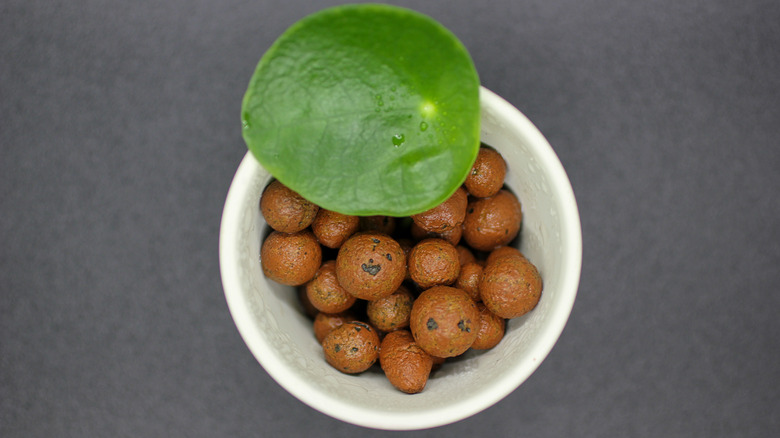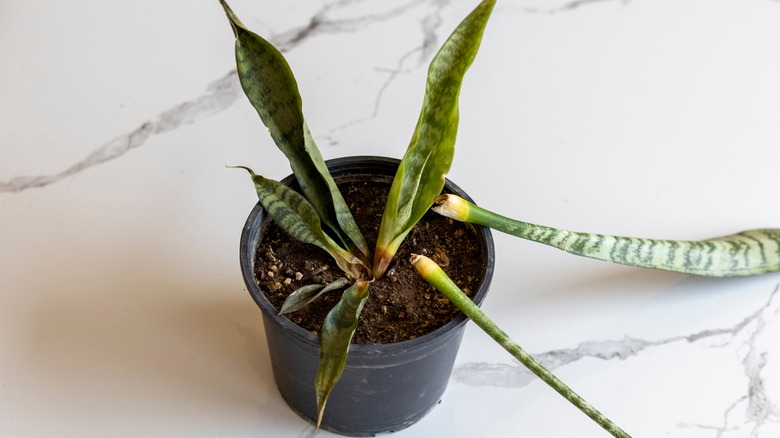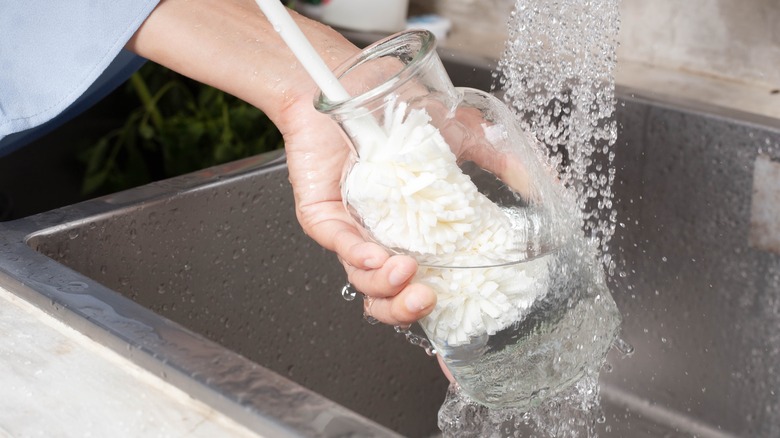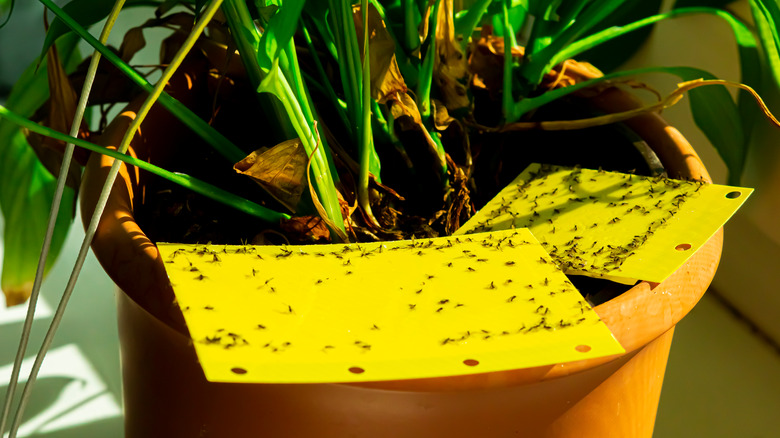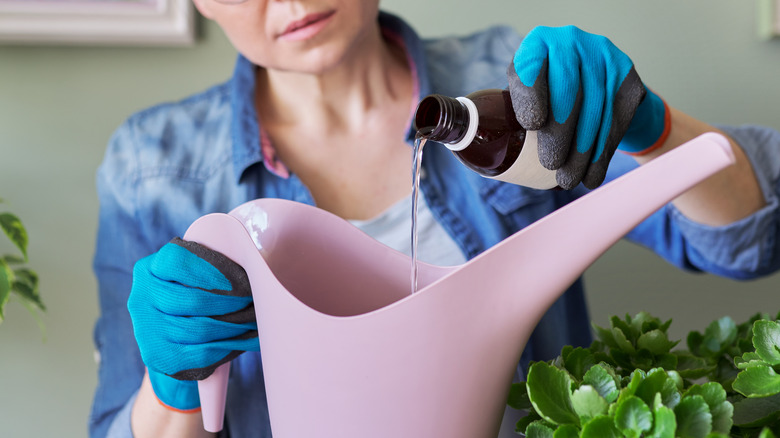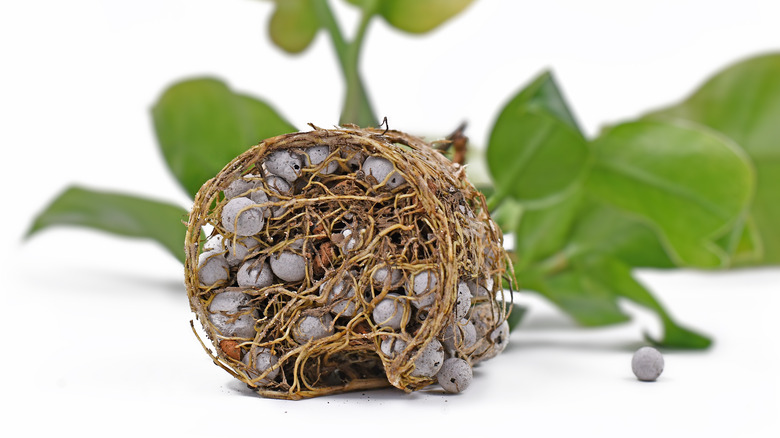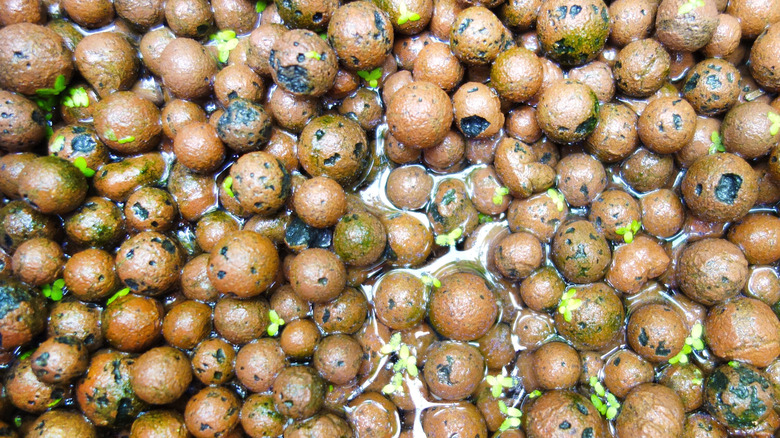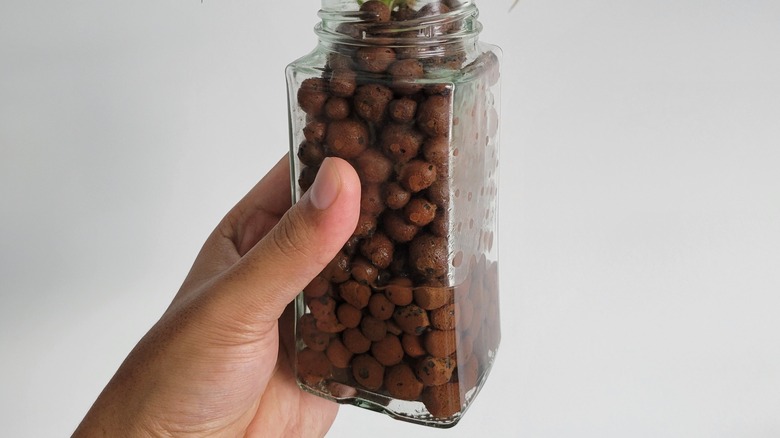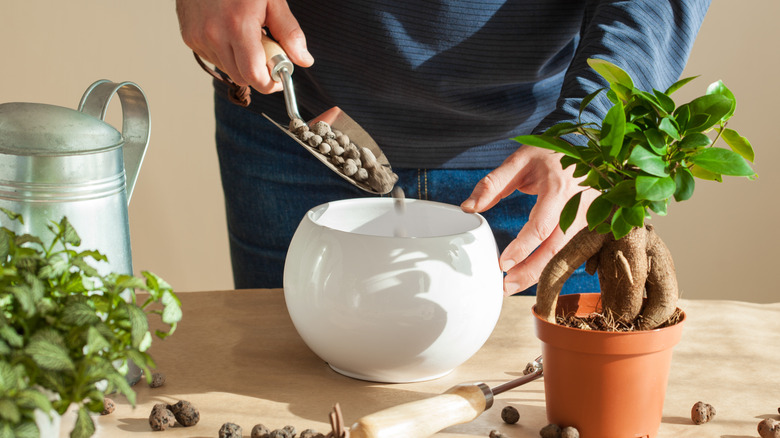The Benefits And Drawbacks Of Growing Houseplants In LECA Instead Of Soil
We may receive a commission on purchases made from links.
LECA has been growing more popular as an aesthetically pleasing soil replacement that adds a decorative touch to nearly any houseplant. As an added bonus, once you get the initial setup out of the way, these little marble-sized spheres make it relatively easy to maintain your plants. LECA, or lightweight expanded clay aggregates, are small clay balls that allow space for necessary plant oxygen and soak up excess water. While they don't provide any nutrients the way soil would, they have other benefits that may make it worth the extra expense (and special fertilizer).
As with anything, there are a few drawbacks to consider before you switch to LECA. This medium is most commonly used for hydroponic gardening, which is a practice used for species that get their nutrients from water rather than soil. However, this doesn't mean you can't use this on other houseplants. Like any changes you make to a plant's environment, you'll need to pay close attention to how your plant reacts to this planting medium. Before getting started, here is a peek at the benefits and drawbacks of growing houseplants in LECA.
Benefit: You face a lower chance of root rot
Giving plants the proper amount of water can be tricky, especially since every variety has its own set of needs. Root rot is a common ailment houseplant owners face, which can occur from watering too often, not having well-draining soil, using a pot without drainage holes, or using soil containing root rot pathogens. Additionally, roots require oxygen, which can be challenging to regulate with soil. Plants with root rot will show signs after the damage is already done, like wilted leaves that have turned yellow. If this happens, you'd need to remove all of the soil, look for mushy dark roots, and remove them.
With LECA, you can take the guesswork out of watering. Overwatering is something nearly every houseplant beginner does at least once by mistake. However, with these clay rocks, you'll only need to water when the water in your pot is gone, eliminating the risk of giving it too much. LECA absorbs the liquid from the bottom, letting roots drink the amount they need. Unlike soil, there's no need to aerate since the clay balls hold plenty of oxygen created by tiny air bubbles and space between the spheres.
Drawback: Watch out for algae buildup
Although you won't have to treat LECA for pests like you would soil, you must keep up with algae buildup. Algae is especially prevalent in setups with clear glass containers because of the direct exposure to the sun. While algae don't directly harm your plants, it can be attractive to pesky bugs like fungus gnats that feed on it. Unfortunately, plant roots are another source of nutrition for these pests, potentially allowing them to transfer pathogens. Once you have an infestation, it can be extremely challenging to eliminate. So, the best course of action is to prevent them from appearing in the first place.
To prevent algae growth, it is recommended to clean the vase or pot every couple of weeks to a month. One simple method uses products that are commonly found in households. All you will need to do is make a paste by mixing ½ tablespoon of salt and a splash of white vinegar. Apply the paste on the vase or pot, concentrating on areas with buildup. Let it sit for at least 10 minutes before rinsing it thoroughly. After rinsing, the vase or pot will look shiny and ready to be refilled with fresh water. Even if the LECA looks fine, it is advisable to rinse it during this cleaning process.
Benefit: LECA reduces the risk of pests
Although it's not possible to completely prevent houseplant pests, using LECA can help you avoid them much more easily. If you've been regularly cleaning your pot and keeping it free of algae, there won't be any living matter in the medium. The porosity of LECA not only benefits the roots of your plants but also makes it more challenging for pests to set up a home. That's because damp soil is incredibly appealing to irritants like aphids and fungus gnats, which require dirt to lay their eggs. By removing their go-to source, you can better keep them away.
Luckily, these pests are not interested in healthy tissue and instead feed on dead leaves, stems, and flowers that fall off your plant. If you switch your houseplants to LECA and regularly clean up any fallen plant parts, you can significantly reduce the likelihood of an infestation.
Drawback: You'll need to fertilize more often
Many people consider LECA as a viable option that can be reused multiple times, and that's true. Unlike other growing media, these clay balls don't need to be replaced since they don't degrade or deplete in nutrients like soil. While this is great, it also means you'll have to fertilize more often than you would with other growing mediums. Soil contains essential nutrients that help plants stay healthy and continue to grow, while LECA doesn't have anything for your plants to feed on. Therefore, it's crucial to fertilize your plants more frequently if you're using LECA.
Not only do you need to use fertilizer more frequently, you'll need to ensure you're purchasing a specific type depending on your houseplant. Normal plant fertilizers won't be potent enough for varieties growing in water or LECA because they aren't packed with micro-nutrients. The soil usually provides that to the plant, so it would be overkill for the products to supply them as well. However, since LECA has none of those micro-nutrients, you need to choose a complete fertilizer that will fill that gap. Hydroponic fertilizers contain those missing nutritional puzzle pieces that will make up for the loss. Flora-Gro is a great one to try, which you can get off Amazon for $14.
Benefit: It's easier to monitor your houseplant's health
Plants have different ways of indicating if they are getting too much or not enough of something. Sometimes, the roots can communicate the problem by appearing mushy, brittle, or overly thin, but it can be hard to detect if you are using soil. You would need to remove the dirt from the roots to diagnose any potential issues. If you don't pay attention to unhealthy roots for too long, your plant will start to show signs of dying, and it might be too late to save it.
However, if you are using LECA balls, you can easily check the roots whenever you want. It's a good practice to do a quick check-up during your regular weekly cleaning routine. Examine the roots for any dark or mushy areas and remove them if you find any. This often means you are overwatering the plant and root rot is forming. If they are brittle and break when touched, that means they are receiving too little water or don't have enough nutrients. If they are tightly bound and compacted, that means it's time to upgrade their pot. This is convenient because you can identify the issue as soon as it happens rather than waiting until it causes damage to the plant.
Drawback: It takes more work upfront
Using potting soil is a straightforward process. You just need to fill the pot with dirt, and you are good to go. However, if you are using LECA, you will need to prepare it before adding plants. Failing to do so could risk the plant's health. That's because rinsing the beads will remove any clay dust from them, which can transfer to your plant roots and damage them. You also don't want to add a fresh plant to dry LECA, as it will absorb all the water during the first watering, leaving little for the roots.
To prepare the clay balls, first rinse them thoroughly to remove any dust. Then, soak the LECA pellets for at least 24 hours to allow water to penetrate deep into the pellets and release any remaining debris. After that, dump out the water and rinse them well. For best results, submerge the pellets in fresh water for another 24 hours. Once you are done with this, you can add your houseplants and water to the LECA.
If you are transferring houseplants from soil to clay pellets, you will need to do even more work to get started. To repot plants in water or LECA, plants require clean roots. You can start by gently rubbing the roots under running water. It may take some time to remove all of the dirt, but it is essential to ensure it is all removed. If you don't, any remaining soil will soak up water from the LECA, causing the roots to absorb excess water. While some plants can tolerate a little extra water, others may become infected with root rot.
Benefit: LECA requires less weekly maintenance
Soil and other media often require aeration to ensure the roots are getting plenty of oxygen. With LECA, there is plenty of space between the pellets, allowing oxygen to circulate freely. Soil may get compacted in areas, meaning more water sits on one side than another. When checking the soil, you may mistake it as dry and accidentally overwater your plant. With LECA, you'll need to water much less frequently, and you'll know exactly when it's time to give your indoor garden a drink due to the pellets being visibly dry.
Repotting plants is also a crucial part of regular houseplant maintenance. Fresh soil provides new nutrients for your greenery; you'll need more as the plant grows. When working with potting mixes, removing all the dirt, refilling the pot, and ensuring the plant is properly placed can take time. This messy process can also be somewhat expensive, especially for larger plants that require a lot of planting mediums. With LECA, repotting is unnecessary unless the houseplant outgrows its container. When that time comes, all you need to do is choose a larger pot, re-add the old LECA, fill it with clean water, and place the plant inside — simple and no mess to contend with.
Drawback: LECA is more expensive
Building an indoor garden will be an investment, no matter what you're working with. However, the upfront costs of LECA tend to be a bit more than generic potting soil, though it depends on factors like location, supplier, your preferred potting mix, and the amount you purchase. To provide your plants with the best living conditions, in addition to purchasing LECA, you'll also need to invest in a pH testing kit to test your water before hydrating your plants. Each plant variety has its own unique preferred pH level, so you will need to look that up before planting it in LECA and giving it its first water. However, most houseplants typically like water to be around the 5.5 to 6.5 pH range. This is important because the correct pH helps the roots absorb nutrients provided by your fertilizer. If the pH is off, your plants might not be able to absorb what they need, and their health will decline. You can use something like the General Hydroponics pH Control Kit found at Walmart for $17.
The biggest cost will come from the fertilizer required to keep your houseplants healthy. While different products vary in price, you can expect to pay around $10 to $20 for a high-quality hydroponics fertilizer. An example of one is the FloraGro on Amazon. When fertilizing plants in soil, you only need to do so a few times per year, depending on the plant. If they're growing in LECA, you'll need to feed your leafy companions at least every other time you water them. The recurring cost of plant food adds up quickly, so switch to LECA only if you can keep up with fertilization.

